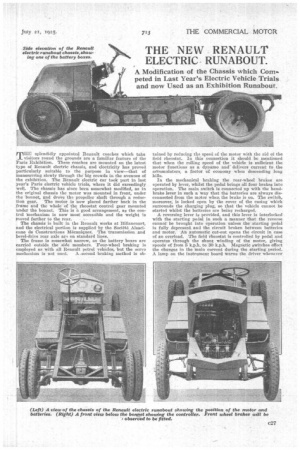THE NEW RENAULT
Page 11

Page 12

If you've noticed an error in this article please click here to report it so we can fix it.
ELECTRIC RUNABOUT •
A Modification of the Chassis which Competed in Last Year's Electric Vehicle Trials and now Used as an Exhibition Runabout,
THE splendidly appointed Renault coaches which take visitors round the grounds are a familiar feature of the Paris Exhibition. Them coaches are mounted on the latest type of Renault electric chassis, and electricity has proved particularly suitable to the purpose in view—that of matunuvring slowly through the big crowds in the avenues of the exhibition. The Renault electric car took part in last year's Paris electric vehicle trials, where it did exceedingly. well. The chassis has since been somewhat modified, as in the original chassis the motor was mounted in front, under the • bonnet, and drove the propeller shaft through a reduction gear. The Motor is now placed farther back in the frame mid the whole of the rheostat control gear mounted under the bonnet. This is a good arrangement, as the control Mechanism is now most "accessible and the weight is
moved farther to the rear. _ The chassis is built in the Renault works at Eillancourt, and the electrical portion is supplied • by the Societe Aisacienne de Constructions MCcaniques. The transmission and bevel-drive rear axle ari on standard lines.
The frame is somewhat narrow, as the battery boxes are carried outside the side memberS. Four-wheel braking is employed as with all Renault petrol vehicles, but the servo mechanism is not used. A second braking method is ob tained by reducing the speed of the motor with the aid of the field rheostat. In this connection it should be mentioned that when the rolling speed of the vehicle is sufficient the motor functions as a dynamo and delivers current to the accumulators, a factor of economy when descending long hills.
In the mechanical braking the rear-wheel brakes are operated by lever, whilst the pedal brings all four brakes into operation. The main switch is connected up with the handbrake lever in such a way that the batteries are always disconnected from the motor when the brake is on. The switch, moreover; is locked open by the cover of the casing which surrounds the charging plug, so that the vehicle cannot be started whilst the batteries are being recharged.
A reversing lever is provided, and this fever is interlocked with the starting pedal in such a manner that the reverse cannot be brought into operation unless the starting pedal is fully depressed, and the circuit broken between batteries and motor. An automatic cut-out opens the circuit in case of an overload. The field rheostat is controlled by pedal and operates through the shunt winding of the motor, giving speeds of from 5 k.p.h. to 30 k.p.h. Magnetic switches effect the changes in the main current during the starting period. A lamp on the instrument board warns the driver whenever the discharge on the batteries exceeds the normal maximum.
The control of the Renault electric vehicle is remarkably similar to that of an ordinary petrol car. The band brake is first released this closes the main switch, but does not start the motor. The starting pedal is depressed to its farthest
position. This releases the reversing lever. The reversing lever is next put into forward or reverse position and the starting pedal allowe I to come up again gently. This move.. meat brings the magnetic switches into operation, as mentioned above, and allows the current to reach the motor by increasing stages. The action of this device in practice is
exactly similar to that of a very sweet-running clutch. The right-hand pedal is next depressed gently. This controls the field rheostat and increases the speed, corresponding, in fact, to an accelerator pedal. A rapid release of this pedal brings the electric braking into ( peration.
The motor runs at an average tension of 80 volts and develops 5 hp. The wheelbase of the car is 3 metres 2 cm., the front-wheel track 1 metre 44 cm., and the rear track 1 metre 17 cm, Twin wheels are fitted at the .rear. The carrying capacity is about 1,250 lb.
In connection with the capacity of the motor for charging the batteries when it is functioning as a dynamo in descending gradients, this point was tested during the electric vehicle trials last year. In climbing the long hill at Bellevue, near Paris, the motor absorbed 670 w. Acting as a dynamo during the descent it gave out 250 w. at an average of 50 amps. The partial charging of the accumulators was thus effected at a charging rate of 4-i hours. The normal capacity of the Tudor batteries in use on this vehicle is 230 amp.hours at a 5-hour rate.
The body ha four rows of seats with doors on the right-hand side, the driver's position being on the left hand. Each seat will seat three persons, so that the body will accommodate 11 passengers. The equipment..incindes a windscreen with two separate hinged panels and a hood. The charges made for the trips in the exhibition are Place de la Concorde to Coin des Metiers, 1 fr. 50 centime's; Cour des Metiers to Place de la Concorde, 1 ft. 50 centimes ; Place de la Concorde to Cow de Metiers and return, 2 fr. 50 centimes.
The service is quite popular with visitors to the exhibition, who use the vehicles as freely as the Raiiodoks are used at Wembley Exhibition.
































